Best Backpacking Water Filters and Purifiers
Let's review our recommendations for the best backpacking water filters currently on the market and our top buying advice.
Any successful trip into the backcountry – be it Utah hiking tours or hiking trips in Yosemite – needs reliable, clean water. Water straight from a creek, river, or lake may contain a plethora of potentially harmful bacterium and protozoa which can ruin a hiking adventure in a spectacular burst of sickness. But that’s why the best backpacking water filters exist, and we’ll cover our favorite choices, how they work, and the top options on the market so you can pick out an effective water filter for your next trip.
Of course, all our Wildland Trekking USA Hiking Vacations include multiple water purification methods, so you’re always guaranteed clean water no matter where you join us – and you never need to worry about filtering water. But if you’re heading into the backcountry on your own, let’s look at the best backpacking water filters so you’re fully equipped for a fantastic trip.
QUICK LIST OF RECOMMENDATIONS
- Best Water Filter Overall – Platypus GravityWorks – View at REI
- Best Inline Water Filter – MSR Thru-Link – View at MSR
- Best Ultralight Water Filter – Katadyn BeFree – View At REI
- Best Water Filter For International Travel – MSR Guardian Gravity Water Purifier – View at MSR
- Best Chemical Water Purifier – Katadyn Micropur Purification Tablets – View At REI
KEY CONSIDERATIONS for the Best Backpacking Water Filters
Why do You Need to Filter Water?
So why filter or purify water in the first place? Even though the water in a flowing river may look crystal clear and clean, it could contain microscopic bacteria – such as E. Coli – or parasitic protozoa – such as Giardia. Both of these tiny interlopers can cause moderate to severe illnesses that will immediately ruin your backcountry trip. Therefore, we filter or purify water.
Filtering water removes bacteria and protozoa from water sources. Generally, this is all you need for any backcountry trips within developed areas (such as the U.S., Canada, and Europe). Meanwhile, purifying water also removes bacteria, protozoa, and viruses (such as norovirus) which are much smaller and more difficult to remove. While water purifiers aren’t necessarily required for most backcountry trips in the U.S., they can be invaluable on international trips to less developed areas of the world where water-borne viruses are a greater concern.
Filter/Purifier Type
Our first task is to take a look at the different types of filters and purifiers. Keep in mind that the exact type of water filter or purifying method you choose will depend on your group size, water source, and personal preference.
Inline/Gravity Filter
This filter type has been quickly gaining popularity in recent years. It typically features a dirty water reservoir filled from the water source that’s then hung or placed in a high position with a tube connected at the base. This tube then connects to the filter/purifier, which hangs beneath the dirty water reservoir, and a second tube runs from the filter down to a clean water reservoir at the bottom of the system. Gravity pulls water from the dirty water reservoir down through the filter/micropores that separate the impurities and then down to the clean water reservoir.
This type of filter can sometimes be fitted directly to a hydration reservoir/bladder and hose. In this case, the pressure of you pulling water through your hose mouthpiece forces water through the filter. This inline setup allows you to fill your hydration reservoir with dirty water but still get clean filtered water as you drink.
Gravity/Inline Filter Benefits:
- Hands-off filtering – let gravity do all the work.
- Can filter large volumes of water easily (great for multiple people)
- Easy to use for cooking, cleaning, or filling multiple water bottles
- Straightforward to clean and maintain
Inline Filter Drawbacks:
- Typically heavier and bulkier than other systems
- Can be tricky to set up in areas without trees where hanging the dirty water reservoir becomes a challenge.
- Hard to fill from shallow water sources – works best with deep or steadily flowing water sources.
Pump Filter
A pump filter uses pressure to pull water from the source via a tube and through the filter for purification. From the filter, another tube feeds the filtered water into a clean water reservoir (or directly into your water bottle). So, unlike gravity filters, pump filters need input from the user to work – normally in the form of a small hand pump.
Pump Filter Benefits:
- Better performance for shallow water sources
- Often a faster filtering process than gravity filters
Pump Filter Drawbacks:
- Takes time and effort to operate
- Harder to clean and maintain
- Often heavier than most other options
Straw Filter
As the name implies, a straw filter is essentially a beefy straw that filters the water as you suck water through it. With this device, you can drink from a water bottle (sometimes included with the straw filter) or drink directly from the source with your straw. Day-hikers and adventurers are typically the only folks using straw filters. This is because the straw only filters as you drink and doesn’t allow you to filter large quantities of water for cooking or carrying.
Straw Filter Benefits:
- Lightweight and portable
- Easy to use quickly – no setup
- Effective for on-the-go hydration
Straw Filter Drawbacks:
- Only filters water as you drink – doesn’t fill up water bottles or reservoirs with clean water
Bottle Filter
Bottle filters essentially incorporate a straw filter in a single integrated soft-sided bottle. All you need to do is squeeze the bottle to force water through the filter. You can drink directly from a bottle filter or squeeze/filter the water into a pot for cooking or Nalgene for storage. Some bottle filters can also function as gravity filters (although not as efficiently as a dedicated inline/gravity filter). However, you should check the instructions beforehand to ensure it has this functionality.
Bottle Filter Benefits:
- Easy to use
- Lightweight
- Can function as a gravity filter (select models only, check beforehand)
Bottle Filter Drawbacks:
- Difficult to filter large quantities of water
- Requires input from the user to function
Chemical Purifier
While filters physically remove impurities – bacteria and protozoa – chemical purifiers kill these organisms (along with viruses) to render them inert and harmless. Iodine and chlorine-based chemicals are the standards and typically render the water safe to drink after waiting the appropriate amount of time (be sure to read the instructions). Chemical purifiers will always come with specific instructions on how to use them, including the ratio of chemical-to-dirty water, wait time, and what bacteria, protozoa, and viruses they protect against.
Chemical Purifier Benefits:
- Very lightweight and compact
- No effort or pumping required
- Excellent secondary (emergency) purifying method to bring into the backcountry
- Can be used for large or small water containers
Chemical Purifier Drawbacks:
- Does not remove impurities from the water – silt, sand, grit, algae, etc. – and is best for reasonably clean water sources (such as glacial streams)
- Takes time to work, and you can’t drink water immediately after treatment
- Can sometimes leave a noticeable taste in the water
- Not effective against 100% of water contaminants – Cryptosporidium is a notable exception that is highly resistant to iodine and chlorine (chlorine dioxide is effective, however). Learn more about Cryptosporidium and filtering in this post from MSR.
UV Purifier
Like a chemical purifier, a UV purifier also inactivates bacteria, protozoa, and viruses. But in this case, the UV light scrambles the DNA of these organisms to prevent them from replicating and making you sick. A UV filter typically takes about 1-2 minutes to purify a liter of water and is either integrated into a bottle or is a small device that you insert into your water vessel and swirl around.
UV Purifier Benefits:
- Effective when used properly in clear water
- No pumping action required
UV Purifier Drawbacks:
- Will not function as well in silty or grimy water (which can shield harmful organisms from the UV light)
- Does not remove silt or grime from the water
- Requires batteries or occasional recharging
Filter Pore Size
As we’ve touched on earlier, most common filters remove bacteria and protozoa while purifiers also tackle viruses. The distinction between these two categories often lies in the filter pore size (the size of the holes that the water passes through). The smaller the pores, the more contaminants they snag and remove from the water.
According to the CDC, filter sizes of 1 micron or less will remove most protozoa, including Giardia and Cryptosporidium. Bacteria, however, are much smaller and require a filter size of 0.3 microns or less to be removed. Therefore, the best water filters will often hover in the 0.1-0.2 micron range in order to remove bacteria and protozoa.
Meanwhile, purifiers must also remove/neutralize viruses, but these little troublemakers are much smaller than bacteria. According to Encyclopedia Britannica, most viruses are between 20 and 250 nanometers (0.02 to 0.25 microns). Therefore, purifiers that still use mechanical filtration must have pore sizes of 0.02 microns or less. These ultra-small pore sizes are difficult and expensive to fabricate. For this reason, chemical and UV purification tend to be the most economical method to tackle viruses unless you’re willing to invest in a very high-quality filter.
Weight/Bulk
As with all our gear, weight and bulk play a prominent role in finding the best water filters for hiking. We all prefer that our equipment be exceptionally small and lightweight, but we have to weigh the pros and cons of that decision before investing. So let’s take a look.
The most lightweight water filters/purifiers are easily chemical purifiers. Each tablet or drop weighs just a fraction of an ounce and takes up almost no space in your pack. However, drawbacks ranging from taste to collecting already clear water (as chemicals don’t remove grit or algae) also limit chemical purifiers’ functionality. On the other end of the spectrum, heavy-duty pump filters can weigh from 1-2 lbs but offer excellent functionality for a variety of water sources.
So think about what you’re willing to carry, if you want a water filter or a purifier, and what you expect it to achieve. Answer these questions, and you’re well on your way to finding the best water filters for you.
Price
While a water filter won’t be the most expensive piece of gear you carry, it’s still worth considering the price. Chemical purifiers tend to be the most economical upfront at around $15 for a pack of 30 tablets. However, filters tend to provide better taste and can filter thousands of liters of water before they need to be replaced. In this regard, we see prices ranging from around $50 up to $275. This cost depends on the quality of the filter, extra features that come with it, and if you’re looking for protection against just bacteria and protozoa or if you want viruses to be removed as well.
So weigh your preferences and budget against your practical needs – i.e., the purifier vs. filter question. Once you settle on what you need, the type of filter or purifier that you prefer to carry, and your price range, you’ll be able to narrow down the field and find the best backpacking water filters for you.
Platypus Gravityworks
Best Backpacking Water Filter
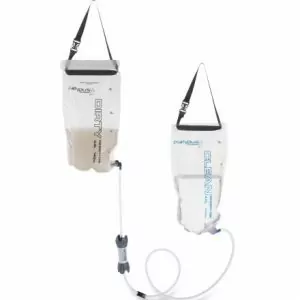
- MSRP: $125 to $150
- Capacity: 2-Liter – 4-Liter – 6-Liter
- Type: Gravity Filter
- Effective Against: Bacteria and Protozoa
- Weight: 11.5 oz.
Pros: Hands-free filtering – Quick filter rate – Large clean water reservoir
Cons: Hard to collect water from shallow or trickling sources – Multiple bags and pieces can be bulky
Closer Look: The Platypus GravityWorks filter blends high-volume filtering with a straightforward and easy-to-use design perfectly suited to the backcountry. It comes with two 2-liter, 4-liter, or 6-liter capacity bags, one for dirty water and one for clean, along with the inline gravity filter and hoses to attach it to both bags. The filter can clean about 1.75 liters per minute, which means you can have plenty of water for drinking, cooking, and cleaning in almost no time at all. The clean water bag has its own strap so it can be hung up and placed in a convenient location, and the hose makes it easy to dispense water quickly and efficiently. We’ve found this filter ideal for hiking groups of two or more – and we love that Platypus offers an easy 2-liter version for one-person adventures (if you don’t mind a slightly bulky setup for your solo trip). All in all, the Platypus GravityWorks filter is our favorite currently on the market and easily one of the best water filters for hiking that you can take into the backcountry.
The reservoir bags now also include a SlimeGuard™ anti-microbial treatment to keep water fresh and clean tasting. After several years of experience in the field, the GravityWorks system has easily proven its reliability and usefulness, and we’re still incredibly pleased with everything this filter has to offer.
Find Your Platypus GravityWorks Filter
MSR Thru-Link
Best Inline Water Filter
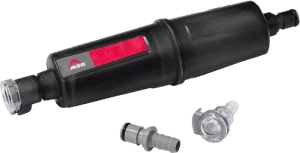
- MSRP: $49.95
- Type: Inline Filter – also functions as a gravity filter
- Effective Against: Bacteria and Protozoa
- Weight: 2.5 oz.
Pros: Lightweight – Very convenient for water reservoirs/bladders – Can double as a gravity filter at camp
Cons: Doesn’t come with compatible water vessels for gravity filter function – Only practical for one person (unless you’re sharing a water bladder)
Closer Look: For hikers who rely on a water reservoir/bladder for on-the-trail hydration, the Thru-Link from MSR is a convenient filter option to seamlessly plug into your hydration system. The lightweight 2.5 oz. filter is compatible with all hydration reservoirs on the market (according to MSR) and simply plugs into the hose system to filter water as you pull water through the system from the mouthpiece. At camp, the Thru-Link can be converted into a gravity filter system where gravity will pull water through the system when the water bladder (dirty water reservoir) is elevated above the filter. However, be aware that you’ll need an additional clean water vessel, bladder, or bottle to complete this gravity filter setup to collect the clean water after it passes through the filter.
Lastly, this inline filter is an awesome choice for solo hikers who use a hydration bladder on the trail. It’s lightweight, easy to pack, and seamlessly integrates into your hydration system. That said, it’s tricky to use as the primary filter for a larger group, so we tend to recommend it only for folks adventuring solo or for groups of two.
Find your MSR Thru-Link Water Filter
Katadyn BeFree 1L
Best Ultralight Water Filter
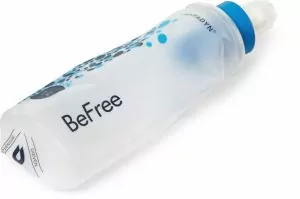
- MSRP: $44.95
- Type: Bottle Filter
- Effective Against: Bacteria and Protozoa
- Weight: 2.3 oz.
Pros: Very lightweight – Good flow Rate – Easy to use and clean
Cons: No added versatility (won’t function as an inline or gravity filter) – Shorter filter lifespan than other options
Closer Look: For ultralight day hikers, trail runners, or even backpackers, the BeFree bottle filter from Katadyn is definitely one of the best backpacking water filters on the market in terms of weight. At only 2.3 oz, this filter and collapsible soft-sided water bottle take up almost no space in your pack. But despite the low weight, the BeFree is a solid and convenient filter. Just fill the wide-mouthed water bottle straight from the source, screw on the lid/filter, and drink from the water bottle as you normally would. The fast flow rate makes it easy to use without having to force water through the filter, and the filter itself is easy to clean by simply swishing it in clean water. So, for hikers looking for a dedicated bottle filter that won’t weigh them down, the Katadyn BeFree is a fantastic choice.
We’re also pleased that Katadyn managed to lower the price a smidge while adding a cover to the drinking nozzle to keep it clean in the backcountry. These are very small items, but we like that Katadyn is continuing to improve and keep its products competitive!
Find Your Katadyn BeFree Bottle Filter
MSR Guardian Gravity Purifier
Best Water Filter For International Travel
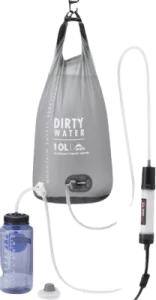
- MSRP: $299.95
- Type: Gravity Purifier
- Effective Against: Bacteria, Protozoa, and Viruses
- Weight: 1 lb. 2.7 oz.
Pros: Purifier removes viruses in addition to bacteria and protozoa – Purge hose for easy cleaning – Very durable
Cons: Expensive – Heavy
Closer Look: Most gravity filters’ greatest weakness is that they don’t remove any potential viruses from the water. While not a problem in the U.S. and Canada, it can be an obstacle in less developed parts of the world, where water-borne viruses are of greater concern. Enter the MSR Guardian purifier. It functions identically to most gravity filters, but the 0.02-micron pore size also removes viruses, making this one of the best backpacking water filters for international travel. Now, we do pay the price for this added protection with a higher up-front cost and a lower flow rate. At 1 liter in 2 minutes, the Guardian has almost half the flow rate of the Platypus GravityWorks. But these tradeoffs may well be worth it for folks looking for a reliable filter to use around the world.
We tested the MSR Guardian Gravity Filter while backpacking through the Himalayan Mountains, and it performed absolutely flawlessly. The Purge hose is a fantastic feature to help flush out the filter, and we utilized it with every use to give the system a quick flush and help keep the flow rate reasonable.
NOTE: MSR also makes the Guardian Pump Purifier that skyrockets the flow rate to 2.5 liters per minute. However, the price also increases dramatically for this pump purifier.
Find Your MSR Guardian Gravity Purifier
View On MSR.comView On REI.com (Filter Only) View On Backcountry.com
Katadyn MicroPur Purification Tablets
Best Chemical Water Purifier
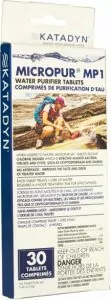
- MSRP: $15.95 (30-Pack)
- Type: Chemical Purifier (Chlorine-Dioxide)
- Effective Against: Bacteria, Protozoa, and Viruses
- Weight: 0.9 oz. (entire package)
Pros: Very lightweight and easy to use
Cons: Takes a very long time for full effectiveness against cryptosporidium (4-hours) – Doesn’t remove any water contaminants such as silt or algae
Closer Look: There’s something to be said for the MicroPur chemical treatment in terms of simplicity and ultralight water cleaning. All 30 tablets weigh less than a single ounce, and each tablet is formulated for 1L of water. No awkward measuring or combining liquid chemical reactants here; just drop the tablet into your water and wait the specified amount of time. Also, the MicroPur tablets use chlorine dioxide, which is effective against bacteria, protozoa (including cryptosporidium), and viruses. However, the tablets need a full 4 hours to work against cryptosporidium and won’t do anything for the aesthetics of the water. So if you have crisp mountain water that just needs a little clean, MicroPur tablets may be an excellent choice. But for more scuzzy water sources, a filter may be a better path.
Find Your Katadyn MicroPur Tablets
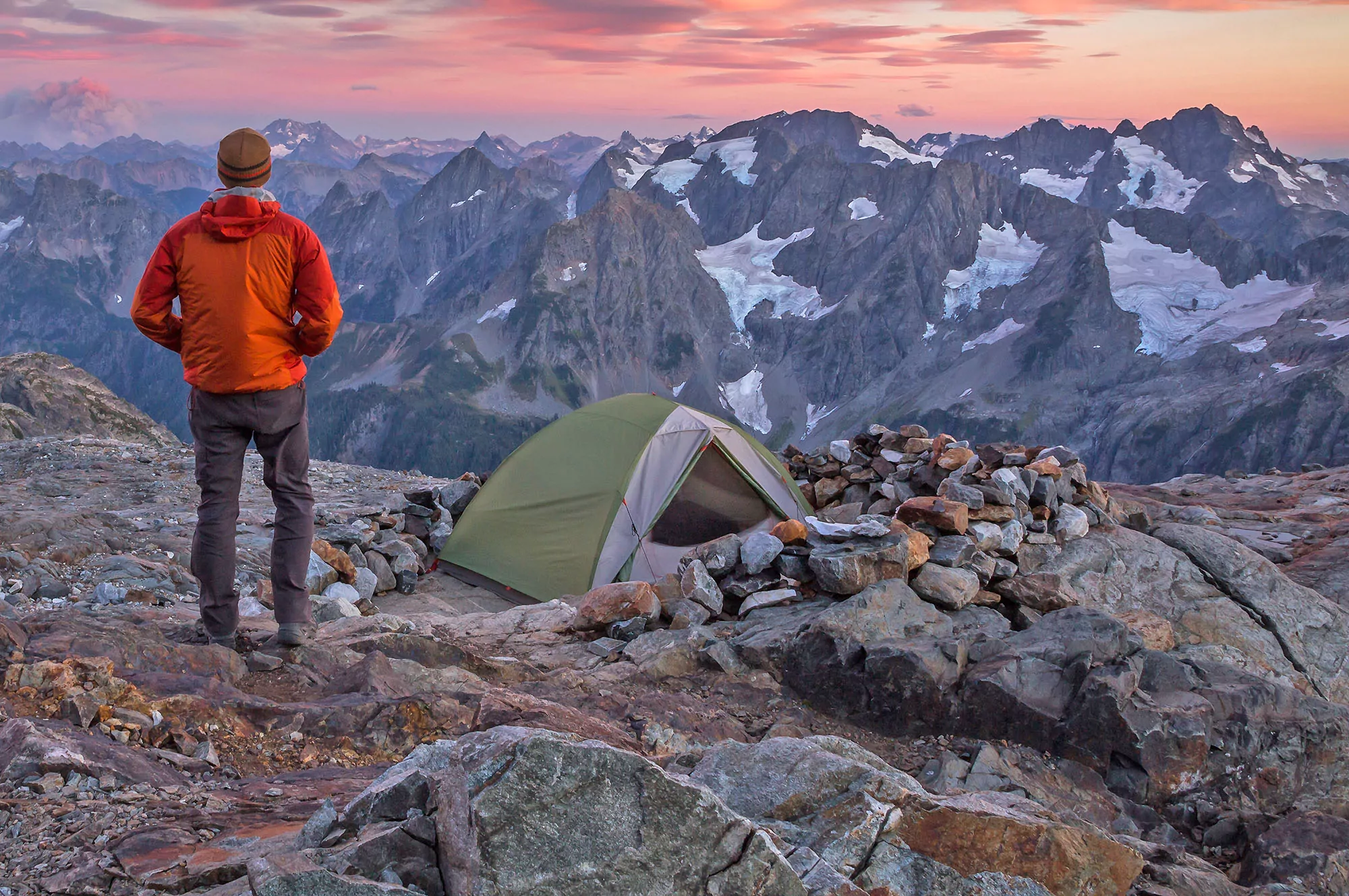
More Information About The Best Backpacking Water Filters
Water filters for hiking and use in the backcountry require consistent care and maintenance in order to continue delivering clean and safe water. Therefore, let’s take a few minutes to go over some filter specifications and maintenance tips to make sure your hydration system is always functioning perfectly.
Filter Lifespan
All filters have a manufacturer designated lifespan. This lifespan is often measured in liters and represents how many liters that particular product should be able to filter before it needs to be replaced. For example, the Platypus GravityWorks filter is good for 1,500 liters, while the MSR Guardian Gravity Purifier should last 3,000 liters.
These numbers represent a lot of water. If you’re able to have your filter cartridge last that long and have reaped the benefits of all that clean water, then it’s a solid investment to purchase a new cartridge to ensure you continue to have reliable and safe water.
Filter Cleaning and Maintenance
Remember, your filter removes tons of bacteria, protozoa, grit, and other contaminants from your water – so it’s worth keeping it in tip-top shape by replacing it when you reach the end of its lifespan. However, all these contaminants can build up over time and slow down your filtering rate long before reaching that total lifespan number. In that case, your filter may just need a little cleaning.
For gravity/inline filters, this typically means backflushing clean water back through the filter – sometimes with a syringe – to dislodge and out flush the contaminants. This process is a little more hands-on for pumps and will vary from model to model, but typically involves unscrewing the housing and manually cleaning the apparatus. Whatever type and model filter you have, always read the manufacturer’s instructions to learn how to clean your filter properly.
Filters in Freezing Weather
Most filters rely on rigid fibers and pores that are manufactured to precise sizes to catch and remove containments. However, water expands when it freezes. So if water is sitting inside your filter and then freezes – on a cold night in the mountains, for example – those expanding ice crystals can damage your filter pores. This can result in unfiltered (dirty) water flowing through your filter without being cleaned.
So take care when using a filter in frigid temperatures, and be sure to read the filter’s instructions for guidance. Most filter manuals will also include a filter integrity test that you can perform if you suspect that your filter may have been damaged.
Why Trust Us?
Choosing the right outdoor gear and apparel can be difficult. But at Wildland Trekking, we live and work with hiking gear every single day. It’s an integral part of what we do, and we understand better than anyone how important it is to have the right equipment. In addition to our vast knowledge of backpacking gear, we also offer:
- Independence – our recommendations are not influenced by partnerships or sponsorships with outdoor gear and apparel manufacturers.
- Experience – as one of America’s top guide companies, we take 8,000-10,000 people on hiking and backpacking tours annually. Since our inception in 2005, we have guided more than 75,000 people into the wilderness.
- Cutting Edge Knowledge – we regularly attend trade shows and pay close attention to the leading edge of new developments.
- Up To Date Recommendations – we update our recommendations regularly as new products are developed and released.
- Dedication to our Readers – we know that the gear we select as our top picks will end up in the field with our readers, and we take that responsibility very seriously. We view our readers as guests on our guided trips, just without the guides. We are committed to helping you be as well-outfitted and prepared as possible for your adventures.
*Disclosure: Some of the links above are affiliate links. At no cost to you, we earn a commission on any products purchased through these links. Any proceeds go to supporting our blog and operations. These affiliate links do not influence the products that we include in our gear round-ups. We only recommend products that we 100% support and that we have used in the field.
MORE GEAR RECOMMENDATIONS
Check out our Wildland Gear Guide for more recommendations about hiking, trekking, camping and outdoor gear. We are always adding new products to help our guests and readers make the best choices to outfit their adventures.
- Packing List Quick Links for Wildland Guests
- Wildland Packing List Video
- Best Low Top Hiking Shoes
- Best Boots for Backpacking Trips
- Best Rain Jackets
- Best Rain Pants
- Best Long Underwear
- Best Mid Layers
- Best Tents for Backpacking Trips
- Best Tents for Car Camping Trips
- Best Backpacking Backpacks
- Best Daypacks
- Best Trekking Poles
- Best Sleeping Bags
- Best Headlamps for Hiking
- Best Backpacking Sleeping Pads
- Best Backpacking Stoves
- Best Hiking Socks
- Best Backpacking Cookware
- Best Hiking Shirts and Tops
- Best Hiking Pants
- Best Camp Shoes
- Best Hiking Shorts
- Best Gaiters
- Best Sun Hats
- Best Sun Hoodies
- Best Hydration Bladders
- Best Duffel Bags
- Best Camp Towels




